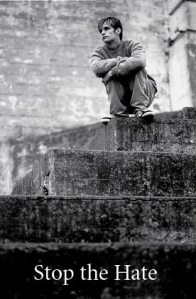
Alan Turing Memorial in Sackville Park, Manchester, England. The statue depicts Turing holding an apple in his right hand, a reference to the way he chose to end his life. That was Turing’s last message to the world, with clear parallels not only to the legendary scientific knowledge of Isaac Newton, but also to the biblical interpretation of forbidden love.
On this date, the mathematician Alan Mathison Turing was born. Turing was a genius and a visionary who foresaw the digital world in which we now live and who believed machines would one day think. In the eyes of scientists today, Turing sits alongside Isaac Newton, Albert Einstein, and Charles Darwin at the table of scientific greats.
Turing’s first professional success came with publication of his paper entitled “On Computable Numbers, with an Application to the Entscheidungsproblem” (1936). In the course of solving Hilbert’s Entscheidungsproblem (Decision Problem), Turing invented the hypothetical device that became known as the Turing machine, and proved that some such machine would be capable of performing any conceivable mathematical computation if it were representable as an algorithm. Andrew Hodges, a biographer of Turing, describes it this way:
The concept of “the Turing machine” is like that of “the formula” or “the equation”; there is an infinity of possible Turing machines, each corresponding to a different “definite method” or algorithm. But imagine, as Turing did, each particular algorithm written out as a set of instructions in a standard form. Then the work of interpreting the instructions and carrying them out is itself a mechanical process, and so can itself be embodied in a particular Turing machine, namely the Universal Turing machine. A Universal Turing machine can be made do what any other particular Turing machine would do, by supplying it with the standard form describing that Turing machine. One machine, for all possible tasks.
It is hard now not to think of a Turing machine as a computer program, and the mechanical task of interpreting and obeying the program as what the computer itself does. Thus, the Universal Turing Machine embodies the essential principle of the computer: a single machine which can be turned to any well-defined task by being supplied with the appropriate program.
This is why Turing is given credit for having invented the principle of the modern computer.
But in the 1930s, when Turing began working on the Entscheidungsproblem, the word “computer” had a meaning different from the one it has today: it meant simply a person who did computations — that is to say, a person engaged in the active use of algorithms. Turing wrote:
We may compare a man in the process of computing a real number to a machine which is only capable of a finite number of conditions q1, q2, …, qR which will be called “mconfigurations”. The machine is supplied with a “tape”, (the analogue of paper) running through it, and divided into sections (called “squares”) each capable of bearing a “symbol”.
The point should be emphasized: Turing was not considering the computing machines of his day. No such machines existed at the time, only calculating devices too crude to undertake any complex mathematics, and certainly not programmable. He was actually modelling the action of human minds. The physical machines would come ten years later.
Turing is best known for his work in cracking the Nazi codes, which gave the allies a consistent intelligence advantage over the enemy, shortening World War II by years and saving millions of lives. “Turing arguably made a greater contribution to defeating the Nazis than Eisenhower or Churchill. Thanks to Turing and his ‘Ultra’ colleagues at Bletchley Park, Allied generals in the field were consistently, over long periods of the war, privy to detailed German plans before the German generals had time to implement them,” said Richard Dawkins. “After the war, when Turing’s role was no longer top-secret, he should have been knighted and fêted as a saviour of his nation. Instead, this gentle, stammering, eccentric genius was destroyed, for a ‘crime’, committed in private, which harmed nobody,” referring to Turing’s sexual orientation.
Turing also devised what is known today as the “Turing Test.” The Turing test is a proposal for a test of a machine’s capability to perform human-like conversation. Described by Alan Turing in the 1950 paper entitled “Computing Machinery and Intelligence“, it proceeds as follows: a human judge engages in a natural language conversation with two other parties, one a human and the other a machine; if the judge cannot reliably tell which is which, then the machine is said to pass the test. It is assumed that both the human and the machine try to appear human. In order to keep the test setting simple and universal (to explicitly test the linguistic capability of some machine), the conversation is usually limited to a text-only channel, such as a teletype machine as Turing suggested.
However, Turing was a gay man living in an era when the word still meant “happy” or “lighthearted” and anyone who acted on a homosexual impulse was subject to criminal prosecution, not only in England where Turing lived but in many other countries as well. Nevertheless, rather naive and somewhat unworldly, Turing was never particularly concerned to hide his sexuality, and throughout his life he spoke openly of his attraction to men.
In 1952, Arnold Murray, a 19-year-old recent acquaintance of Turing’s, helped an accomplice to break into Turing’s house, and Turing went to the police to report the crime. As a result of the police investigation, Turing acknowledged a sexual relationship with Murray, and a crime having been identified and settled, they were charged with gross indecency under Section 11 of the Criminal Law Amendment Act of 1885.
Turing came to trial on 31 March 1952 and made no serious denial or defense, instead telling everyone that he saw no wrong with his actions. He was particularly concerned to be open about his sexuality even in the hard and unsympathetic atmosphere of his profession in Manchester, England. Turing was convicted of the same crime Oscar Wilde had been convicted of more than 50 years before. He was given the choice between imprisonment or probation, the latter conditional on his undergoing hormonal treatment designed to reduce libido. To avoid going to jail, he accepted the estrogen hormone injections, which lasted for a year, with side effects including gynecomastia (breast enlargement). His lean runner’s body took on fat. His conviction led to a removal of his security clearance and prevented him from continuing consultancy for the Government Communications Headquarters (GCHQ) on cryptographic matters. At this time, there was acute public anxiety about spies and homosexual entrapment by Soviet agents. In America, Robert Oppenheimer had just been deemed a security risk.
On June 8, 1954, his housekeeper found Turing dead, with a half-eaten apple left beside his bed; the previous day, he had died of cyanide poisoning. The apple itself was never tested for contamination with cyanide. The autopsy revealed that Turing’s stomach contained four ounces of fluid that smelt of bitter almonds: a solution of a cyanide salt. His death was not accidental; there was enough poison to fill a wine glass. Turing, thought the pathologist, had taken bites from the apple to make his last drink more palatable. Although he left no note, most believe that his death was intentional; Turing had himself spoken of suicide. His mother, however, strenuously argued that the ingestion was accidental due to his careless storage of laboratory chemicals. Biographer Andrew Hodges suggests that Turing may have killed himself in this ambiguous way quite deliberately, to give his mother some plausible deniability. Others suggest that Turing was reenacting a scene from “Snow White”, reportedly his favorite fairy tale. It has even been suggested that Turing’s suicide was in fact the work of the British secret service determined to remove a security risk.
Interestingly, in 1928 while a student at Sherborne School, Turing fell in love with a boy one year ahead of him in school, Christopher Morcom. The boys bonded over their shared passion for science. Unfortunately, on 13 February 1930, Turing’s beloved Christopher died at the age of 18 of bovine tuberculosis, which he had contracted years earlier when he drank tainted milk. His death profoundly affected Turing and may have spurred his intellectual achievements.
In his biography of Turing, Andrew Hodges refers to an essay Turing wrote to the mother of his deceased boyfriend:
He fell in unrequited love with Christopher Morcom, a very talented youth in the school sixth form, and his longing for friendship brought him to communicate. A brief flowering of scientific collaboration perished when Morcom suddenly died in February 1930 of tuberculosis. Turing’s correspondence with the dead boy’s mother gives insight into the development of his ideas in the aftermath. He was concerned to believe the dead boy could still exist in spirit, and to reconcile such a belief with science. To this end he wrote for Mrs Morcom an essay [entitled ‘Nature of Spirit‘], probably in 1932. It is the private writing of a twenty-year-old, and must be read as testament to background and not as a thesis upheld in public; nevertheless it is a key to Turing’s future development.
The essay begins with a general account of the influence of developments in physics and quantum mechanics on the scientific conception of the universe, then moves quickly into the question of free will:
It used to be supposed in Science that if everything was known about the Universe at any particular moment then we can predict what it will be through all the future. This idea was really due to the great success of astronomical prediction. More modern science however has come to the conclusion that when we are dealing with atoms and electrons we are quite unable to know the exact state of them; our instruments being made of atoms and electrons themselves. The conception then of being able to know the exact state of the universe then must really break down on the small scale. This means that the theory which held that as eclipses etc. are predestined so were all our actions breaks down too. We have a will which is able to determine the action of the atoms probably in a small portion of the brain, or possibly all over it. The rest of the body acts so as to amplify this.
In stating the classic paradox of physical determinism and free will, Turing is influenced by Arthur Stanley Eddington’s assertion that quantum mechanical physics (“more modern science”) yields room for human will. Eddington asked how could “this collection of ordinary atoms be a thinking machine?” and Turing tries to find some answer.
There is now the question which must be answered as to how the action of the other atoms of the universe are regulated. Probably by the same law and simply by the remote effects of spirit but since they have no amplifying apparatus they seem to be regulated by pure chance. The apparent non-predestination of physics is almost a combination of chances.
Here, Turing says that although the atoms, in their action, “seem to be regulated by pure chance” (emphasis added), in fact they are “probably” subject to the same “will” by means of which we as human beings are able to control at least a small portion of our brains. Thus the “remote effects of spirit” have not, in fact, been banished.
As McTaggart shows matter is meaningless in the absence of spirit (throughout I do not mean by matter that which can be a solid a liquid or a gas so much as that which is dealt with by physics e.g. light and gravitations as well i.e. that which forms the universe). Personally I think that spirit is really eternally connected with matter but certainly not always by the same kind of body. I did believe it possible for a spirit at death to go to a universe entirely separate from our own, but now I consider that matter and spirit are so connected that this would be a contradiction in terms. It is possible however but unlikely that such universes may exist.
Then as regards the actual connection between spirit and body I consider that the body by reason of being a living body can “attract” and hold on to a “spirit,” whilst the body is alive and awake the two are firmly connected. When the body is asleep I cannot guess what happens but when the body dies the “mechanism” of the body, holding the spirit is gone and the spirit finds a new body sooner or later perhaps immediately.
As regards the question of why we have bodies at all; why we cannot live free as spirits and communicate as such, we probably could do so but there would be nothing whatever to do. The body provides something for the spirit to look after and use.
By the time of the publication of “Computing Machinery and Intelligence” in 1950, Turing had decided that artificial intelligence was possible — a machine could be built that could have the qualities of a human mind — which his now-famous test was designed to detect. In his paper he addressed an argument opposed to his view:
This argument is very well expressed in Professor Jefferson’s Lister Oration for 1949, from which I quote. ‘Not until a machine can write a sonnet or compose a concerto because of thoughts and emotions felt, and not by the chance fall of symbols, could we agree that machine equals brain — that is, not only write it but know that it had written it. No mechanism could feel (and not merely signal, an easy contrivance) pleasure at its successes, grief when its valves fuse, be warmed by flattery, be made miserable by its mistakes, be charmed by sex, be angry or depressed when it cannot get what it wants.’ This argument appears to be a denial of the validity of our test. According to the most extreme form of this view the only way by which one could be sure that a machine thinks is to be the machine and to feel oneself thinking. One could then describe these feelings to the world, but of course no one would be justified in taking any notice. Likewise according to this view the only way to know that a man thinks is to be that particular man. It is in fact the solipsist point of view.
The gist of Turing’s view now was that the existence of consciousness (“but know that it had written it”) is an illusion, a quality emerging from and ultimately to be explained by great complexity. His approach would not accept “intentionality” as any better an explanation than “spirit” or “soul”. In this conviction he is close to Buddhism. “I do not wish to give the impression that I think there is no mystery about consciousness,” he wrote. “There is, for instance, something of a paradox connected with any attempt to localize it.”
The mystery of how matter comes to support human mind was the burning theme of Alan Turing’s lifelong inquiry. In 1932, he believed that “spirit” could live on, and in a sense he proved that yes, it could. In the end, Christopher Morcom’s spirit lived on not in his body but in a wholly different form, in the work of Alan Turing.
References:
- Blackmore, Susan (2002). There is no stream of consciousness, Journal of Consciousness Studies, Volume 9, numbers 5-6: 17-28.
- Eddington, Arthur Stanley. The Nature of the Physical World 1926–1927 (Cambridge, UK: Cambridge University Press, 1930).
- Hodges, Andrew. Alan Turing: the Enigma (Princeton, NJ: Princeton Univ. Press, 2012, 1983).
- Leavitt, David. The Man Who Knew Too Much: Alan Turing and the Invention of the Computer (New York, NY: W. W. Norton & Company, 2006).
- McTaggart, J.M.E. The Nature of Existence 2 volumes. (Cambridge, UK: Cambridge Univ. Press, 1921-27).
- Turing, A.M. On Computable Numbers, with an application to the Entscheidungsproblem, Proc. Lond. Math. Soc. (2) 42: 230-265 (1936); correction ibid. 43: 544-546 (1937).
- —————- (1950). Computing Machinery and Intelligence, Mind 59: 433-460.





























You must be logged in to post a comment.